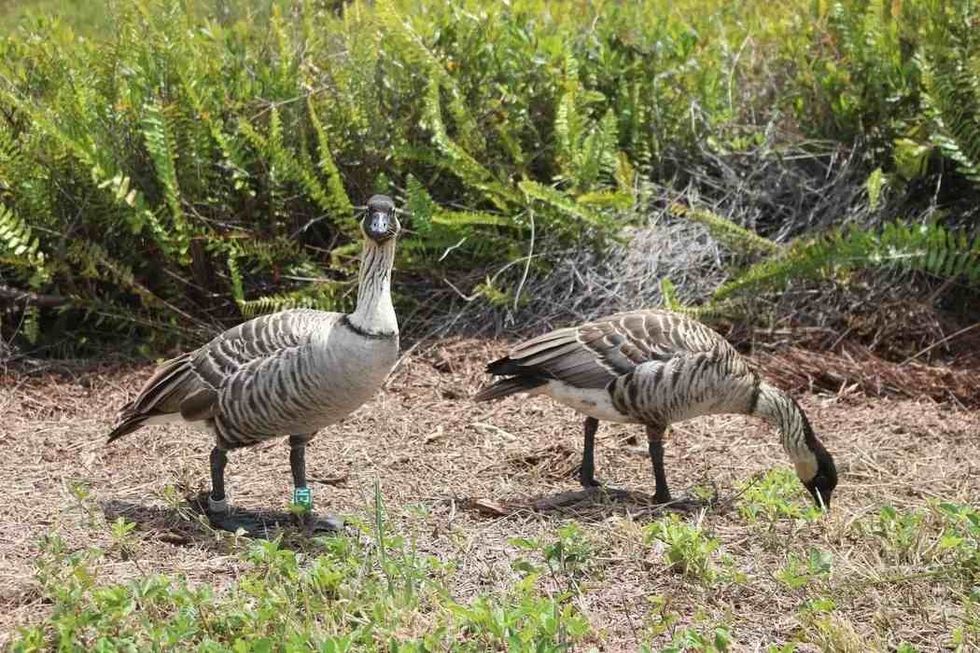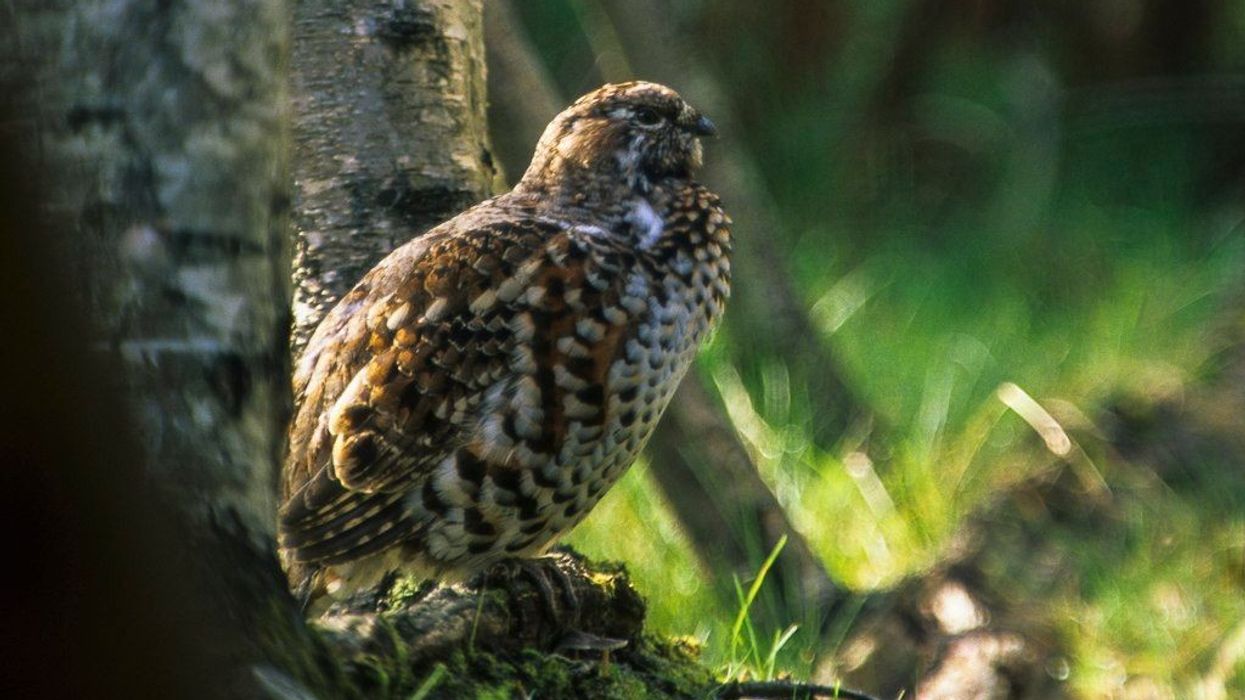The Nene goose is closely related to the Canada goose and is known to have evolved on the Hawaiian Islands. As its population is found on these islands, namely in Hawaii, Kauai, and Maui, it is known as the state bird of Hawaii.
Nene geese are brown and gray birds. Their eyes, bill, legs, and feet, are black and males cannot be particularly distinguished from females based on their physical appearance.
This bird species is found on the islands of Kauai, Hawaii, Maui, Oahu, and Molokai. Today, they are also found in England due to the extended breeding experiments to help increase their population.
An interesting fact is that these birds can walk on lava. Due to their strong legs with a comparatively low webbed texture, it is easy for these geese to walk on the lava flow. This means that they are found on lava lands, along with open grasslands, shrublands, and interestingly enough on golf courses, too.
Read on for more insightful facts about these nene geese. To know more about other animals, check out our articles on African pygmy geese and mongeese.
Nene Goose Interesting Facts
What type of animal is a nene goose?
A nene goose is a Hawaiian bird that belongs to the Anatidae family of animals.
What class of animal does a nene goose belong to?
This Hawaiian goose belongs to the Aves class of animals.
How many Nene geese are there in the world?
Hawaiian nene geese are considered to be the world's rarest and most endangered species. Today, the nene population comprises only 3000 birds across the world in the wild and wildlife refuge areas.
Where does a nene goose live?
As the name suggests these Hawaiian geese are found in the Hawaiian Islands, especially in the native Hawaiian wildlife. They live on the islands of Kauai, Maui, Oahu, and the big island of Hawaii.
As their population reached the brink of extinction, these endangered birds were transported to England to increase their numbers through scientific breeding processes. This has led to a successful increase in their breeding numbers, and their population is slowly increasing once again.
What is a nene goose habitat?
These birds prefer living in the wild and their native Hawaiian habitat. They are mainly found in coastal dunes, active lava lands, grasslands, shrublands, and pastured areas. These wild birds are also spotted around golf courses due to their vast open lands.
Who does nene goose live with?
This species of Hawaiian geese have a close-knit social structure. They are spotted in flocks. Although, they follow a hierarchy system and give the most respect to the family with the most members. A group of Hawaiian geese together is known as a flock or a gaggle.
How long does a nene goose live?
This state bird of Hawaii, named the Hawaiian goose, has a good lifespan of around 28 to 42 years of age, especially when living in wildlife refuge areas.
How do they reproduce?
These nene geese share a life-long bond with their partners. They have an extended and comparatively long breeding season.
During this breeding season, males try to get females' attention by walking in front of them. Once a female agrees, males perform a few special calls and activities as a celebration. This is done before they breed together to match each other's wavelength.
Females lay around one to five eggs, with an average of three eggs in one brood. Their breeding season is between October and March.
Females are known to incubate the eggs alone, which are then protected by male geese. A male protects the nest building as well as the females from predators or any other threats. Goslings become independent almost a year after their birth.
What is their conservation status?
Although this bird's population is increasing in number, it is still considered to be the world's rarest goose. Their numbers on Maui, Kauai, and the whole island of Hawaii have dropped low because of hunting and predatory acts.
They were carefully bred in England and Hawaii, and this act of bringing them back from the brink of extinction was successful. These closely endangered nene geese are now listed under the Vulnerable category by the International Union for Control of Nature for the wild animal population.
Nene Goose Fun Facts
What does a nene goose look like?
This species of endangered birds have similar features irrespective of their gender. They have a small bill while the legs and feet of nene geese are long.
Their feet have fewer webbed patterns than other geese. This helps them to walk easily on any grass and land, even with lava flowing on it. A Hawaiian goose's bill, legs, and feet are black.
Their eyes as well as the ends of their tail are black too, with cream-colored cheeks and a long neck that has black streaks, and a white and black stripe on their throat. Their body is usually a blend of grays and brown streaks of feathers all over.
How cute are they?
Baby goslings are cute little Hawaiian geese. Adult Hawaiian geese look equally as pretty, especially when they flare their wings, showing off the dark and light-colored streaks all over their feathers.
How do they communicate?
This species of bird is tactile and vocal. They use their touch senses and sound along with visual aids for communicating.
They have loud shrieky calls that they use during mating and while alerting the flock of any predators or threats around. They also use slight murmuring sounds while foraging for food and they have different calls with different intensities for greeting, distress, and pleasure. These calls are exceptionally loud before or during their breeding time.
These birds also use body movements and gestures to communicate. For instance, bending the neck at a particular angle shows that the bird is trying to warn about a threat.
How big is a Nene goose?
This nene Hawaiian goose is five to six times larger than the African pygmy species, with an average length of 21-26 in (53 -66 cm).
How fast can a nene goose fly?
Nene Hawaiian geese have smaller wings in comparison with other species of geese. They fly at lower heights, mainly from their nesting to the ground, but do not have a great flight speed.
How much does a nene goose weigh?
Nene Hawaiian geese are just a little smaller than Canadian birds of their species and have an average weight of 3.36-6.72 lb (1.5-3 kg).
What are the male and female names of the species?
Nene Hawaiian geese have different terms or names based on their gender. A male is called a gander, while a female is called a goose.
What would you call a baby nene goose?
The babies of this species of birds are known as goslings.
What do they eat?
This population of birds is considered to have a nutritious diet that consists of most of the grasses present on the islands of Hawaii. They forage in the wild and try to pick up food from the ground with the help of their long neck and strong beak.
They pull out flowers, grasses, fruits, seeds, and pluck leaves, as food supplies for themselves as well as for their young ones.
Are they dangerous?
This species of bird is the state bird of Hawaii and there haven't been any reports of its dangerous or aggressive behaviors in its native breeding lands.
Would they make a good pet?
Although they are not considered dangerous, their population is low and they have been classified as an endangered species. Therefore, keeping them in captivity or keeping them as a pet is illegal. Hawaiian geese are conserved in national parks in Maui and Hawaii and are not kept as individual household pets.
Did you know...
The name, Nene, is pronounced as 'nay-nay'. The bird is known to make calls and some might say it sounds like a cow's moo or a Canada goose's honk.
These birds have a positive role to play in the ecosystem. Not only do they have a role in the food web by being included in their predators' diet, but they also help in random tree plantations.
These birds are known to eat seeds and during the foraging process, they help to spread these seeds across the islands giving rise to new smaller plants.
What eats a nene goose?
This nene Hawaiian goose has a long list of predators across the world. This list consists of animals like mongeese, hawks, feral cats, owls, falcons, and wild rats.
They are also hunted by humans for various rituals that consist of wild food feasts. Most of these predators do not just go hunting for the birds, but they also feed on the eggs which is one of the reasons for their conservation vulnerability.
What is the rarest goose?
The Hawaiian goose nene's scientific name is Branta sandvicensis. This name came from the term that translated to 'Sandwich Islands' in Latin and was named by Captain James Cook.
This bird was close to extinction and yet came back. This is a sign of national pride for Hawaii, and a nene goose is now considered to be the rarest goose species around the world.
Here at Kidadl, we have carefully created lots of interesting family-friendly animal facts for everyone to discover! Learn more about some other birds including the Bateleur eagle or Atlantic puffin.
You can even occupy yourself at home by drawing one on our Nene Goose coloring pages.










